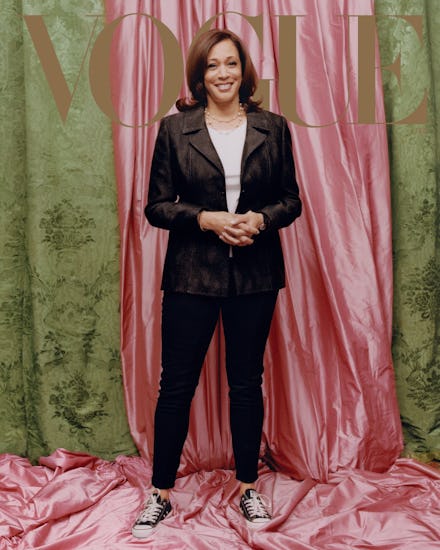Kamala Harris's 'Vogue' cover continues a hurtful trend of diminishing powerful BIPOC women

Growing up, I always found myself gravitating to the magazine and book aisles of grocery stores. There was something about their glossy covers and glossier subjects that would catch my eyes. Would I ever find myself in their shoes? In those patent leather stilettos? "Getting on the cover of Vogue" was an aspirational phrase I heard among my peers and in the pop culture at large. At my young age, that was my conception of the American Dream, an admittedly idyllic one that contrasts the practical, hardworking ethos of my parents, immigrants from India.
There are specific hallmarks of those Vogue issues I found myself thumbing through during those supermarket visits back then and, by habit, today — the piercing gazes, grandiose attire, sweeping scenery. Those who grace the covers exude confidence and gravitas.
But for myself and many social media users, the iconic fashion magazine's February print cover featuring Vice President-elect Kamala Harris, in casual clothing, with a somewhat uncertain expression, was a major disappointment. More than a debate over mere aesthetics, however, this treatment of Harris shines a light on the continued hurtful trend of diminishing powerful BIPOC women.
Clad in a black moto jacket and a pair of slacks, Harris looks at the camera with clasped hands and raised eyebrows, caught in what appears to be bewildered, even uncomfortable laughter. She dons a pair of black Converse, a staple of her campaign trail, posing in front of a silk curtain backdrop of bubblegum pink and lime green — an homage to Harris’s membership with Alpha Kappa Alpha, a historically Black sorority, at alma mater Howard University.
The photographer, 26-year-old Tyler Mitchell, made history as the magazine’s first Black photographer to shoot a cover, when he shot Beyonce Knowles-Carter’s September 2018 issue. Both the author and editor-at-large responsible for the shoot, Alexis Okeowo and Gabriella Karefa-Johnson, are Black. Their direction was spot-on, particularly their nod to Black sorority culture's subtle but meaningful influence in shaping the first woman VP-elect. Still, the relaxed imagery is jarring amid the billowing gowns, dramatic lighting, and towering headdresses of Vogue covers past.
Harris’s print cover certainly makes her look relatable. Perhaps that was her goal, seeing that the VP-to-be reportedly picked out the ensemble herself. Still, such casualness undermines the gravitas of Harris’s milestone as not only the nation’s first Black and South Asian VP, but also the person who will play a critical hand in undoing four years of harmful and destructive policies via the Trump administration.
The unfortunate reality with BIPOC’s representation in media — many photoshoots will find themselves embroiled in controversy but usually at no fault of the subjects themselves.
The real drama centers around Vogue’s decision to use the pink-and-green photo as the print issue cover, instead of the photo of Harris in a fittingly regal powder blue pantsuit, a move that "reportedly blindsided the Harris team," a source told CBS News.
Who's to blame for this shady business? Some point the finger at Anna Wintour, the magazine’s famed editor-in-chief. While we don't know how true that is, Wintour has come under fire in the past for devaluing people of color.
In a statement to the New York Times' Kara Swisher on Tuesday, Wintour defended the cover: “It was absolutely not our intention to, in any way, diminish the importance of the Vice President-elect’s incredible victory.” (Swisher also notes that there wasn't a contractual agreement affirming that the powder blue suit would be the print cover.)
Vogue has seen its fair share of criticism calling out “subpar” covers of BIPOC figures. When Simone Biles was featured in its August 2020 issue, the celebrated gymnast received unanimous praise for her interview, in which she bravely detailed longtime USA Gymnastics doctor Larry Nassar’s harrowing sexual abuse. The cover’s photographer, Annie Leibovitz, however, faced backlash for unflattering lighting choices that, like Harris’s photo, appear to dull the gymnast’s radiant skin, undermining the strength and resilience that defined Biles’s profile.
But here’s the unfortunate reality with BIPOC’s representation in media — many photoshoots will find themselves embroiled in controversy but usually at no fault of the subjects themselves. Remember the debate that surrounded Alexandria Ocasio-Cortez’s Vanity Fair cover in October, also photographed by Mitchell? Some (ahem, conservatives) took issue with the price tags of the outfits Vanity Fair provided her, calling her one step short of a socialist hypocrite, despite her struggling to afford an apartment in D.C.
In terms of formality, the two covers are worlds apart: the Vanity Fair cover featured AOC’s iconic white pantsuit and red lipstick, a look that maintains a delicious trifecta of elegance, power, and symbolism, in stark contrast with the “authentic, approachable nature” Vogue claims it was trying to convey in Harris’s easygoing cover. Yet, both women’s debuts, watershed moments in representation for BIPOC women everywhere, were undermined by controversy reflecting a systemic undervaluation of their legacies.
I myself am a South Asian woman. Make no mistake, I feel some type of way about the VP-elect’s unsavory legacy with criminal justice. And that’s why representation, while necessary, is imperfect — an intricate dance between unadulterated admiration and resigned acknowledgement. But I feel a swell of pride when I see that Harris has attained all that’s unattainable, someone whose mother is also an immigrant hailing from India, though a few hours away in the bustling city of Chennai.
Speaking for Black women, Robin Givhan, senior critic-at-large of the Washington Post, summarizes this discontent best: “Nothing about the cover said, ‘Wow.’ And sometimes, that’s all Black women want, an admiring and celebratory ‘wow’ over what they have accomplished.”
That pink-and-green cover of Harris will grace newsstands everywhere for the nation and its young women in supermarkets to pass by, flip through, and preserve. It shouldn’t even have to be said, but Harris’s rise to Vice President of the United States deserves formality and respect — not a shoddy cover swap.